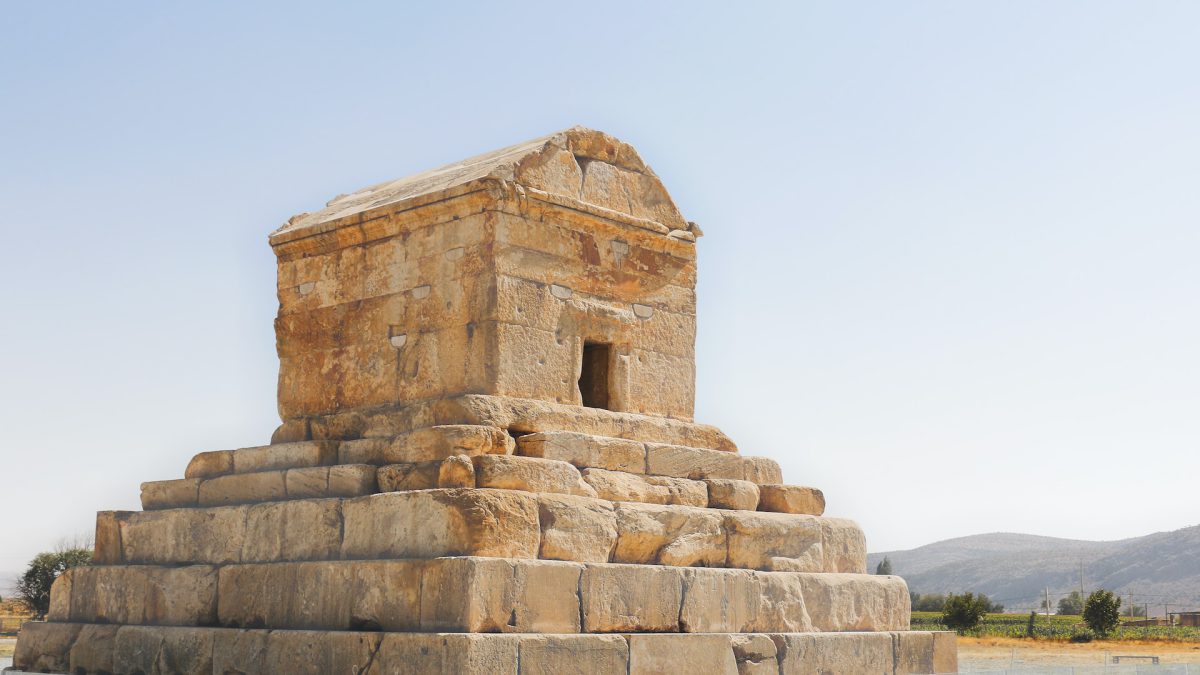Table of Contents
Pasargadae is located in a high plain about 1900 meters above sea level, in a mountain fence. In the seventh lunar century, a mosque was built near the tomb of Cyrus the Great, in which palace stones were used, and on the occasion of the 2500th anniversary of the Persian Empire in 1971, these stones were returned to their original places.
This valuable collection was registered on July 7, 2004, as the fifth work of Iran in the list of UNESCO heritage sites.
Builders of Pasargadae
From the evidence left by Pasargadae, it is clear that it was mostly considered to be made by Cyrus the Great. This theory is strengthened for several other reasons:
First; The tomb of Cyrus the Great, which he built, shows such a connection in terms of design and use of landscaping in the middle of the great garden of Pasargadae with the gate, private and bar palaces. It turns out that the designer is all the same and those palaces are the result of Cyrus the Great have been.
Second; The trilingual inscriptions of Elamite, Ancient Persian, and Akkadian on the rafters and gates of the three palaces indicate that they were associated with Cyrus.
Third; the type of architecture and especially the style of Pasargadae masonry shows a short history of Persepolis architecture that began from the beginning of the reign of Darius the Great.
Therefore, there can be no doubt that the buildings began with Cyrus the Great.
Pasargadae Complex and Its Most Important Parts
Architects and experts consider the Pasargadae complex to be the beginning of the evolution of Iranian architecture. This place marks the beginning of the glorious era of Achaemenid architecture.
This place was the capital of the first empire that is different from the rest of the world and has created wonders. In the north, we see the Pasargadae Fortress or the famous Throne of Solomon. In the southern part of this campus is a tomb that is the eternal residence of Cyrus. This collection has several sections that include:
Tomb of Cyrus the Great
The tomb of Cyrus the Great is located in the southern part of this royal complex and is built in such a way that it can be seen from all directions in the Pasargadae plain. A very simple and at the same time beautiful building that the builders built, including the stairs, with a height of 11 meters and an area of nearly 160 square meters.
In fact, the general structure of the tomb of Cyrus can be considered as consisting of two parts. The base of the tomb, which is the first part of the building, is a platform made of 6 steps and the second part of the tomb is a small room with a sloping roof on which the builders placed it above the first part.
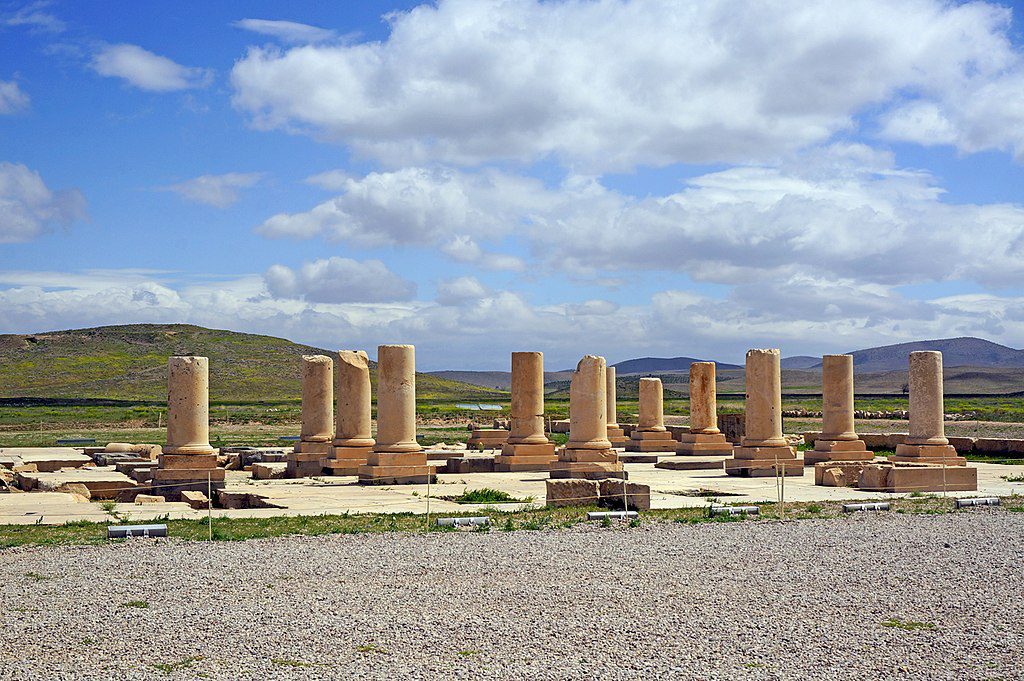
All the outer parts of the tomb are built on seven floors and on top of each other, and probably the designer of the building has considered and implemented this type of design due to the sanctity of the number seven. The foundation stone of the tomb is white and yellowish limestone, which is likely to have been extracted from the Sivand mine, which is located 30 km from Pasargadae.
The chamber of the tomb is more than two meters high and has walls 1.5 meters thick. The stones carved in four rows, which are beautifully and carefully placed on top of each other, are two very heavy pieces of stone on the floor of the tomb, and the roof covering is also made of stone. A noteworthy point about the architecture of the tomb of Cyrus is that no mortar is used in the construction of the building.
This feature is also present in the architecture. However, experts believe that the use of metal fasteners, which are probably made of iron and lead, in connecting the stones to each other is one of the most important reasons for the remarkable strength of Cyrus the Great Tomb.
Cyrus tomb is the only building that is described in Greek sources. One of the oldest descriptions of the tomb of Cyrus is that of Aristobulus, one of Alexander III of Macedon’s companions in his expedition to the Achaemenid Empire, recorded by Arian in Alexander’s Anabasis. According to evidence, during the reign of Cambyses, the Magi, who were in charge of maintaining Cyrus the Great grave, received a quota of one sheep and a certain amount of wine and food per day, and one horse per month to sacrifice to Cyrus the Great.
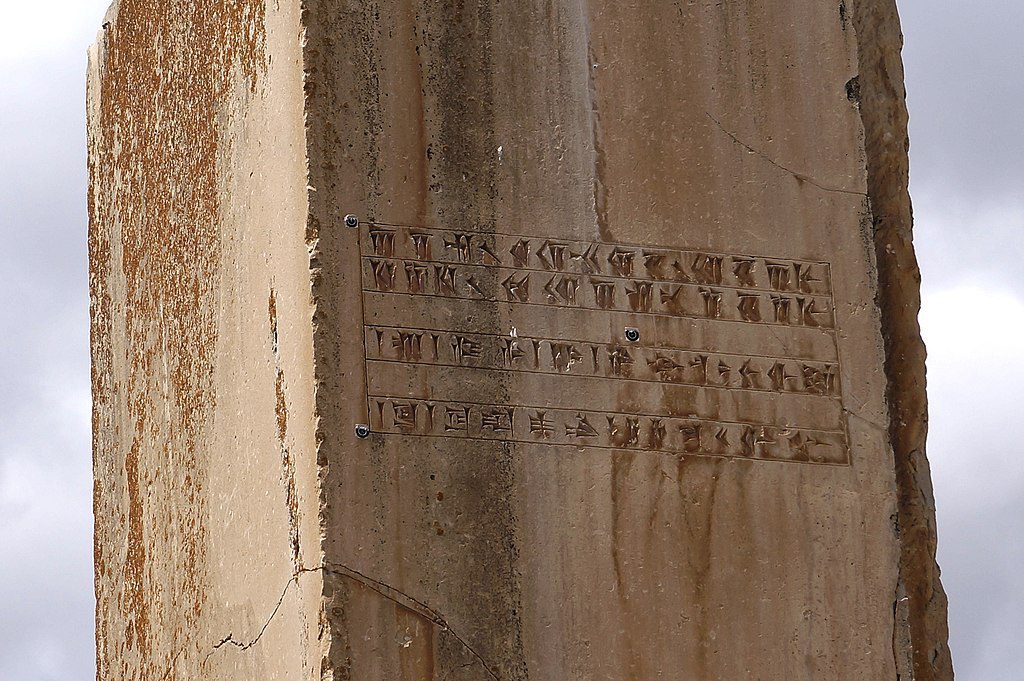
During the Islamic period, the true purpose of the building remained unknown to people. Moreover, the construction of such magnificent stone structures was regarded as a feat beyond human capabilities. Interestingly, Islamic beliefs associated the tomb of Cyrus the Great with Solomon, who, according to legend, commanded the giants to undertake arduous tasks. Consequently, the tomb of Cyrus was sometimes regarded as one of the buildings associated with Solomon. In fact, it was attributed to his mother and referred to as the “Mashhad of Suleiman the Mother.”
Public Palace or Cyrus Reception Palace
The area of this palace is 2472 square meters, which was built on the northwest-southeast axis. The palace consists of a large central hall with eight columns, which is 705 square meters. Four porches on the four sides of the palace with smaller columns and two rooms form the other main parts of the building. The height of the palace hall was a few meters higher than the ceiling of the surrounding porches.
Of the eight columns of this hall, only one of its columns is standing, and the current height of this column reaches 13.10 meters.
The underside of the columns and the tops of the columns of the central hall are made of black stone and the cuttings of the columns are made of white stone. The other pillars of the hall were moved to Atabakan to build a mosque around the tomb of Cyrus, which has now been returned to its original location. The central hall is connected to the four porches of the palace by four doors.
There are two large rooms on either side of this porch. In one part of the palace, you will see inscriptions in three languages Persian, Elamite, and Babylonian a text is written which in modern language reads “I am Cyrus the Achaemenid king.”
Tomb of Cambyses (Suleiman Prison)
The tomb of Cambyses II, the conqueror of Egypt, is one of the most beautiful buildings in this complex, which dates back to the beginning of the Achaemenid period. It is a quadrangular and tower-like building, of which only one wall now remains, and is located in the path of private and public palaces. The height of the tower is about 14 meters and its base is 23.7 x 27.7 meters, which is located on a three-step height.
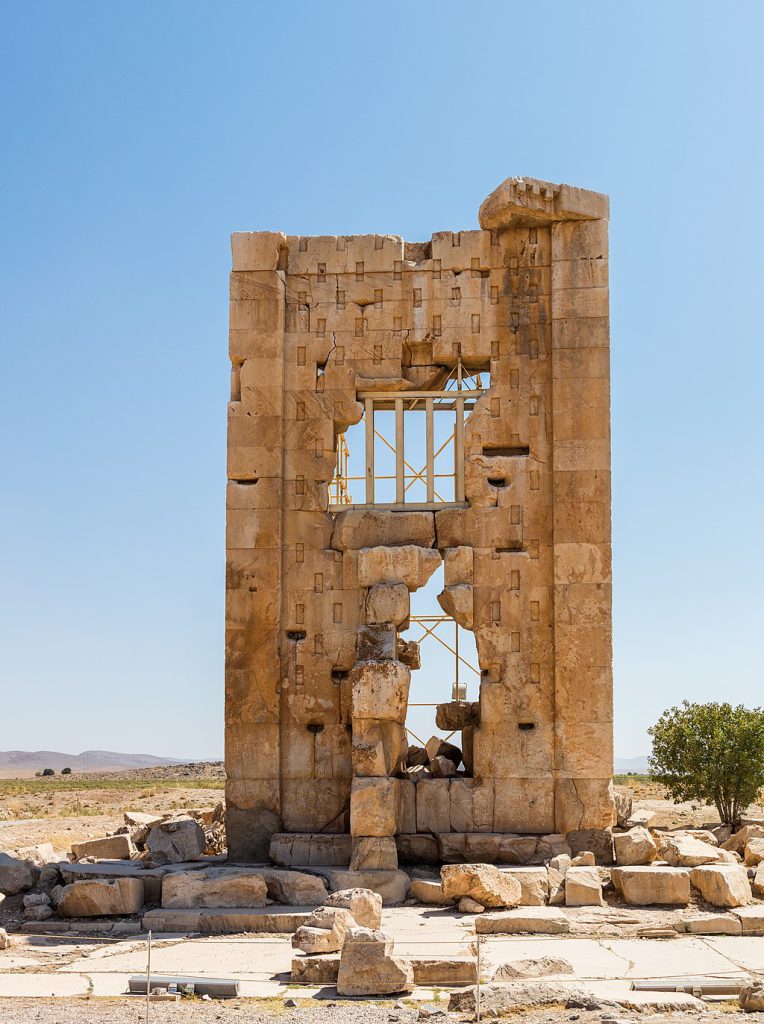
From an architectural and artistic point of view, this building is considered one of the masterpieces of Achaemenid engineers and artists. The stone blocks are stacked in such a way that in some ridges it is difficult to distinguish the two blocks. The stones used in the construction of the building are white marble facade stones that were brought from the Sivand mine.
The tomb of Cambyses, now known as a fire temple from the time of Cyrus the Great, is a unique work that has been inscribed on the World Heritage List as a prison building. This building was known as Suleiman Prison during the Islamic period.
Winged Man Lithography
The beautiful lithograph of the winged man in Pasargadae, which shows the interconnectedness of thought and art, shows a man with a thick beard, a long robe, and a crown. This lithograph has four wings facing the center of the palace. The decorative and artistic elements of the lithograph are very beautiful, impressive, and meaningful.
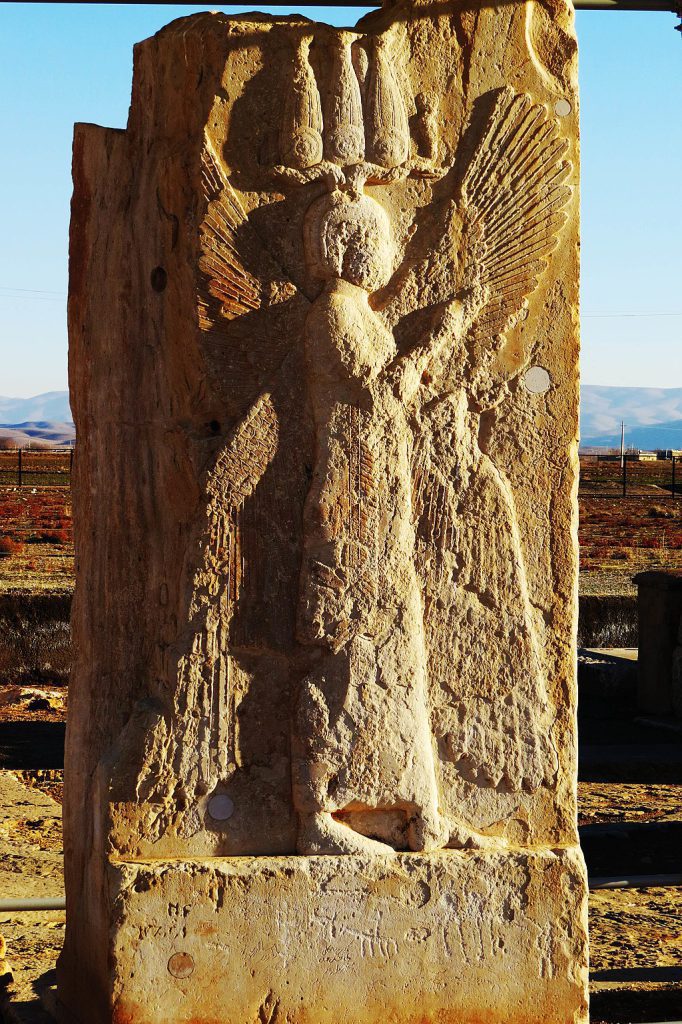
Above the petroglyph of the winged man is a beautiful crown with a wild ram on its long, twisted branches, while two cobras are placed one behind the other, each holding a ball symbolizing the sun. Three bouquets of reeds form the main part of the crown, each with a sphere of the sun above it and surrounded by ostrich feathers. The ends of these three bouquets are covered by three large spheres of the sun.
The wings have been shown solely to give a sense of proportion while two wings are extended towards the sky and two wings are extended towards the ground. The man’s body is covered with a long, fringed robe adorned with roses. The arms are one forward and the other along the wing upwards, while the legs are bare.
The image of the winged man is engraved from the profile and faces left, inwards, and towards the center of the hall. In addition to the face, the body and legs of this man are also to the right. It was as if he was facing the hall. The left hand of the relief is almost hidden behind the body, but the right hand rises in front of the chest, and the fingers of the hand are wide open, showing a posture similar to “hello” or “prayer”.
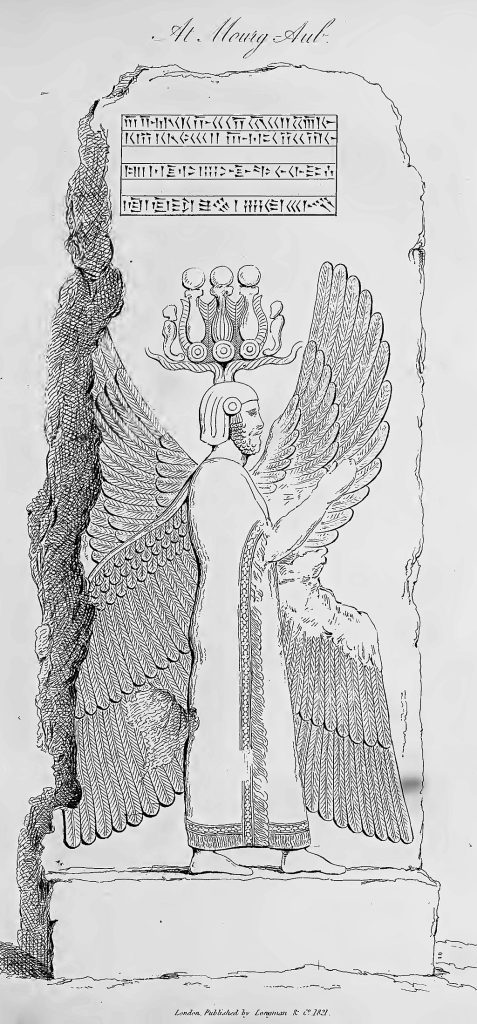
In the formation of this conceptual lithograph, the art and culture of different nations have been used. For example, the crown of a winged man is inspired by the land of Egypt. This crown is designed on three floors, which some experts have considered as a concept of the trinity of Zoroastrian culture (good speech, good deeds, and good thoughts). Men’s long dress is one of the long dresses of Elam and the wings of lithograph are rooted in Assyrian culture.
The use of the art of different nations in this lithograph is taken from the lofty ideas of Cyrus in the exchange of cultures. In fact, each part represents the presence of representatives of different nations, created with the idea of equality of human beings of any color, race, and language.
Private Palace
It is clear from its name that this palace belonged to Cyrus the Great and was the residence of the king. The palace has a large hall with east and west porches, which are the main entrances. Also, according to the old architecture, it has two side entrances. The private palace is located in the north of Pasargadae Park, which represents the residential part of the Achaemenid palace.
Pasargadae Shiraz, the place where the tomb of Cyrus the Great is located, is one of the oldest places in Iran where every person who steps in realizes its infinite wonders. Also, its reputation has gone out of the border of Iran. Although unfortunately, many parts of it have been ruined or destroyed, it still retains its glory. Many tourists have Pasargadae and Persepolis at the top of their list of places to visit in Iran. To visit Pasargadae, you can easily choose one of To Iran Tour’s packages below, or just simply tell us your interests by filling out the form and tailor-make your own travel to Iran.
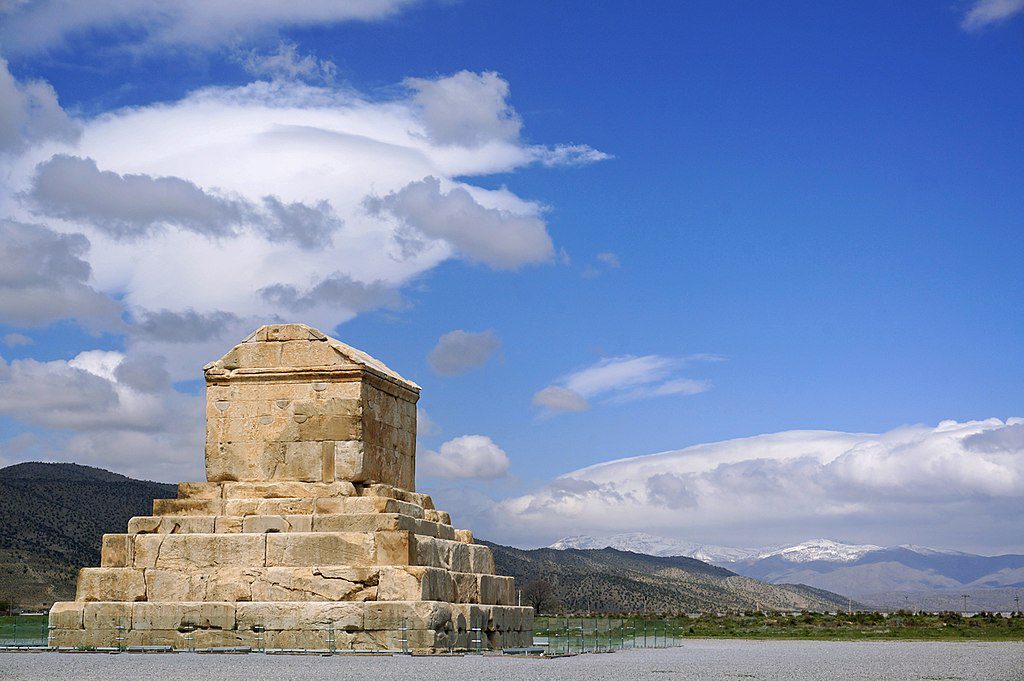
The Baked Clay Bank at Pasargadae
Pottery, an essential archaeological resource, abundantly found in ancient sites, holds immense significance in various research fields, including cultural communications, chronology, comparative stratigraphy, belief systems, and daily life studies. It serves as a crucial source of information about the thoughts, ideas, and artistic expressions of past civilizations.
Within the UNESCO World Heritage site of Pasargadae, extensive archaeological research and excavations spanning several decades have yielded a substantial collection of pottery artifacts. Primarily originating from the Tang-e Bolaghi excavations, conducted by collaborative Iranian and international teams, these pottery fragments provide valuable insights into the region’s historical context. Additionally, pottery discoveries from other sections of the Pasargadae region have also contributed to our understanding of the area’s cultural heritage.
Recognizing the need for improved storage conditions, a dedicated facility, known as the Baked Clay Bank, was established to house and preserve the pottery finds. To ensure optimal preservation, a container was refurbished and transformed into a suitable storage unit. Inside the container, robust and standardized metal shelving structures were installed, replacing the inadequate plastic and wooden boxes previously used. These new shelves provide a secure and organized environment for the pottery artifacts.
Prior to storage, meticulous care was taken to prepare the pottery fragments. Each piece was thoroughly cleaned and sorted before being placed inside new, appropriately sized fabric bags. Detailed information about each bag’s contents was recorded on newly created labels, facilitating efficient retrieval and documentation.
The Baked Clay Bank not only safeguards the pottery artifacts but also supports further scholarly endeavors. Special study objects and museum-quality cultural materials are given separate, labeled cases, ensuring their distinct preservation and accessibility. This systematic organization enables researchers to conduct in-depth explorations, investigations, and studies, fostering a greater understanding of Pasargadae’s rich cultural heritage.
The establishment of the Baked Clay Bank at the Pasargadae World Heritage site exemplifies a commitment to scientific standards and best practices in the preservation and management of cultural materials. By providing a well-maintained and accessible repository for pottery artifacts, this initiative facilitates ongoing research, contributes to the advancement of knowledge, and fosters a deeper appreciation for Iran’s remarkable archaeological heritage.
How to get to Pasargadae
Visiting the Tomb of Cyrus the Great in Pasargadae is a remarkable journey into ancient Persian history. Here are some ways to reach this captivating site:
By Air:
The nearest international airport to Pasargadae is Shiraz International Airport. Several airlines offer regular flights to Shiraz from major cities around the world. Upon arrival, you can hire a taxi or take a private transfer to Pasargadae, which is approximately 130 kilometers north of Shiraz. The journey by road takes about 2 to 2.5 hours, depending on traffic conditions.
By Train:
Although Pasargadae does not have its own train station, you can travel to Shiraz by train from various cities within Iran. The Iranian railway network connects Shiraz with major cities like Tehran, Isfahan, and Yazd. Once you arrive at Shiraz Railway Station, you can hire a taxi or arrange for private transportation to reach Pasargadae.
By Bus:
An affordable and convenient option is to travel by bus. Shiraz has a well-developed bus network that connects it with other cities in Iran. Several bus companies operate regular services to and from Shiraz. You can find both VIP and standard buses, depending on your preferences. Once you arrive at Shiraz’s main bus terminal, you can take a taxi or hire a private car to reach Pasargadae.
By Car:
If you prefer the freedom and flexibility of driving, you can rent a car in Shiraz and embark on a scenic journey to Pasargadae. The route from Shiraz to Pasargadae is well-maintained and signposted, making it relatively easy to navigate. It’s important to note that driving in Iran requires an International Driving Permit (IDP) along with a valid driver’s license.
Upon reaching Pasargadae, you will find the Tomb of Cyrus the Great within the archaeological complex. The site is open to visitors, and you can explore the tomb and other nearby attractions at your own pace. It is advisable to wear comfortable shoes and bring sun protection, as the site involves walking outdoors.
Immerse yourself in the historical significance of the Tomb of Cyrus the Great, and let the ancient wonders of Pasargadae transport you to the glorious past of Persia.
Recommended Sightseeing Time of Pasargadae
Pasargadae, a window into Iran’s ancient culture, is a must-see for history enthusiasts. To make the most of your visit, it’s important to time it right.
During winter, Pasargadae opens its doors from 8:30 a.m. to 5:30 p.m., giving you plenty of daytime for exploration. In the summer, these hours are extended, from 8 a.m. to 7:00 p.m., allowing you to enjoy the warm sun and stunning sunsets. Whether you’re an early bird or prefer the magic of a late afternoon, this place lets you create lasting memories in this historic setting. So, step into the past and let Pasargadae’s stories enrich your journey.
Where to Eat near Pasargadae
Experience the taste of Iran in Pasargadae at Bamdad Restaurant and Pasargad Restaurant. Bamdad Restaurant offers dishes like saffron-infused rice, juicy kebabs, and flavorful stews that take you on a journey through Iran’s food traditions.
Meanwhile, Pasargad Restaurant in the heart of the city serves a mix of classic and lesser-known Persian dishes, giving you a delicious blend of old and new. These restaurants not only fill your belly but also let you savor the flavors of Iran’s past and present.
Where to Eat near Pasargadae
Persepolis Apadana Hotel
Persepolis Apadana Hotel offers a real Persian experience. With cozy rooms and a restaurant serving local food, it’s your ideal spot for a good night’s sleep after a day of exploring the historic sites.
Atlas Hotel
The Atlas Hotel is a calm place near Pasargadae, mixing modern comfort with traditional style. The big Persian-themed rooms create a peaceful atmosphere. It’s your starting point for adventures with easy access to Pasargadae and the surrounding area. After your explorations, relax in the beautiful gardens or enjoy local dishes at the hotel’s restaurant. Staying here guarantees you’ll make lasting memories while discovering ancient marvels.
Other Attractions near Pasargadae
Persepolis: The Splendid Capital of the Achaemenid Empire
Located approximately 50 kilometers northeast of Pasargadae, the awe-inspiring ruins of Persepolis stand as a testament to the grandeur and opulence of the Achaemenid Empire. As the ceremonial capital of the empire, Persepolis showcases magnificent palaces, intricate reliefs, and monumental staircases, providing a glimpse into the artistic and architectural achievements of ancient Persia. Marvel at the towering columns, explore the Throne Hall, and admire the intricate carvings depicting Persian mythology and royal processions. Persepolis is a UNESCO World Heritage site and a must-visit destination for history enthusiasts.
Naqsh-e Rustam: Royal Tombs and Rock Reliefs
A short distance from Pasargadae, Naqsh-e Rustam is an ancient necropolis housing the tombs of Persian kings from the Achaemenid and Sassanian dynasties. Carved into the rock face, these monumental tombs, including the Tomb of Darius the Great, captivate visitors with their grandeur and historical significance. The site also features impressive rock reliefs portraying victorious battles and royal ceremonies. Naqsh-e Rustam offers a captivating blend of history, art, and natural beauty, making it a compelling stop for those exploring the region.
Pasargadae Park: Serene Natural Surroundings
Adjacent to the Tomb of Cyrus, Pasargadae Park offers a tranquil setting where visitors can unwind amidst picturesque landscapes. This green oasis provides an opportunity to relax and absorb the peaceful ambiance while appreciating the historical significance of the surrounding archaeological sites. Enjoy a leisurely stroll through the park, discover lush gardens, and relish in the serene atmosphere, complementing your exploration of Pasargadae.
Shiraz: The Cultural Hub of Iran
Just a short drive south of Pasargadae lies Shiraz, a city renowned for its rich cultural heritage and exquisite gardens. Explore the vibrant bazaars, immerse yourself in the poetry and history of the famous poet Hafez, and marvel at the stunning architecture of the Nasir al-Mulk Mosque. Don’t miss the tranquil beauty of the Eram Garden, a UNESCO World Heritage site, known for its stunning botanical collection and architectural charm. Shiraz offers a delightful fusion of history, art, and Persian hospitality, providing a captivating extension to your visit to Pasargadae.
When visiting the Tomb of Cyrus in Pasargadae, take the opportunity to explore these nearby attractions, each offering a unique perspective on the historical and cultural wonders of Iran. From the grandeur of Persepolis to the serenity of Pasargadae Park and the enchantment of Shiraz, these destinations promise an unforgettable journey through ancient civilizations and contemporary Iranian culture.
FAQs about Pasargadae
Q1: What is the significance of Pasargadae in terms of its location and historical context?
A1: Pasargadae is located in a high plain about 1900 meters above sea level, nestled among the Zagros Mountains. It holds historical importance as it was the chosen command center of Cyrus the Great, the founder of the Persian Empire.
Q2: Which period is most closely associated with the cultural prominence of Pasargadae?
A2: The Achaemenid period is considered the most significant cultural era of Pasargadae. It was during this time that Cyrus the Great built structures and palaces, establishing Pasargadae as his capital.
Q3: What evidence supports the theory that Cyrus the Great was primarily responsible for the construction of Pasargadae?
A3: Several factors support the attribution of Pasargadae’s construction to Cyrus the Great. Firstly, the design elements and landscaping of the tomb of Cyrus show a connection to the surrounding palaces, indicating a unified vision. Additionally, trilingual inscriptions found on the palaces’ rafters and gates associate them with Cyrus. The architectural style of Pasargadae also aligns with the early Persepolis architecture that began during Darius the Great’s reign.
Q4: What are the main sections or structures within the Pasargadae complex?
A4: The Pasargadae complex consists of several notable sections. These include the Tomb of Cyrus the Great, the Public Palace or Cyrus Reception Palace, the Tomb of Cambyses (Suleiman Prison), the Winged Man Lithography, and the Private Palace.
Q5: What are the key features and characteristics of the Tomb of Cyrus the Great?
A5: The Tomb of Cyrus the Great is situated in the southern part of the Pasargadae complex and is easily visible from all directions in the plain. It is a simple yet beautiful structure composed of two parts: a platform with six steps as the base and a small room with a sloping roof on top. The tomb is built with white and yellowish limestone, and the absence of mortar in its construction is notable. The use of metal fasteners, possibly made of iron and lead, contributes to the strength of the tomb.
Q6: What was Pasargadae and why was it important?
A6: Pasargadae was the main city of the earliest big mix of cultures in Western Asia. It covered an area from the Eastern Mediterranean and Egypt to the Hindus River. It’s known for being the first empire that accepted and valued the cultural differences of its various groups of people.
Q7: What is the meaning of the name Pasargadae?
A7: Pasargadae means ‘protective club’ or ‘strong club’ in ancient language. This city served as the capital of the Achaemenid Empire during the rule of Cyrus the Great from 559 to 530 BC.
Q8: Is Pasargadae and Persepolis the same?
A8: Archaeologists have found signs of an ancient settlement in the area, but writings suggest that the city’s actual building began when Darius I took charge. He was from a new royal family branch and chose Persepolis as the capital of Persia, taking over from Pasargadae, where Cyrus II (known as Cyrus the Great) was buried.
Q9: Why did Cyrus build Pasargadae?
A9: The buildings in Pasargadae were built because Cyrus the Great, who lived around 550-530 B.C., wanted to show that he had created a huge empire with people from many different nations.
Q10: What are some possible reasons that Cyrus chose the location of Pasargadae?
A10: Cyrus chose the place for Pasargadae because it was near a big river delta, gave him a good military advantage, and had a connection to his family’s history. This location was useful in both practical and symbolic ways for his empire.
Last words: Unlock the Treasures of Pasargadae with ToIranTour
Pasargadae is an ancient mountain spot with a mosque near Cyrus the Great’s tomb, built in the 7th century using his palace stones. In 1971, they put the stones back to mark the Persian Empire’s 2,500th birthday. Cyrus liked Greek-style buildings from a city called Sard in 545 BC.
If you are planning to travel to Iran and immerse yourself in the rich history and archaeological wonders of the country, embarking on a knowledge-based and archaeological tour is an excellent choice. By exploring Iran’s archaeological sites, you can delve into the captivating stories of ancient civilizations and witness the remarkable remnants of the past.
To Iran Tour specializes in Iran tours and travel packages that cater to the diverse interests and preferences of travelers. Whether you are fascinated by ancient ruins, archaeological excavations, or the cultural significance of historical sites, To Iran Tour offers a range of options to cater to your specific interests. We’re here to help you have a great experience in Iran, and we can’t wait to be a part of your next adventure.

